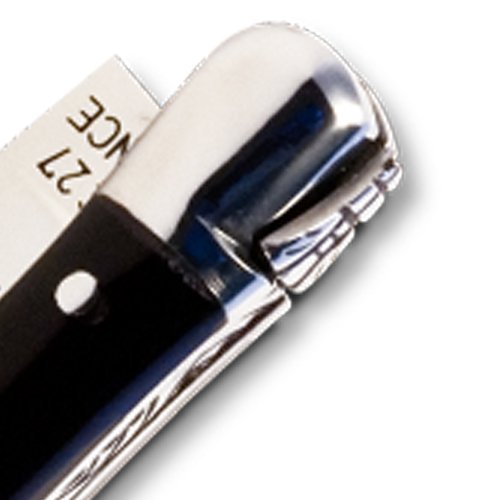

Menu
Menu


The Club collects information from all amateurs of knife-makingIf you want to speak about something important for you, don't hesitate contact us.

To be classed as a forged knife, the knife must be made out of a single piece of steel and entirely forged (blade, bolster and tang).
Forging works the steel fibres, resulting in a better cut.
To ensure the optimal cutting edge, special stainless steel, with a high carbon content is chosen. (C50C13)
The blade is the most important part of a kitchen knife.
In 'false' forged knives (where knives are soldered or semi-forged), only the bolster is forged. The blade is made out of a single piece but not forged.
Bands of steel are cut into billets, carefully calculated to conform to final specification of the knives.
These are then heated to 1150° centigrade to enable the process of hot forging to take place.
The red hot billets are carefully placed under a very strong drop hammer in a 3-part mould which exactly corresponds to the size of knife which is being produced.
Three hits or blows of the massive drop hammer are needed, one in each section of the mould, to forge the billet into the require shape.
Showers of sparks accompany this operation :
After forging the knife is returned to the furnace and heated to 800° C. This makes it malleable once more, in order to trim the rough shape to the form required.
The handle or tang is then pierced with exacting precision so the rivets can be mounted to the handle.

Tempering gives hardness to the knife to ensure a long lasting cutting edge. It is a very important operation.
First the knife is dressed (straightened) to prevent excessive warping during the tempering process.
The knives are carefully placed in special trays. They are put into the furnace at 1060° centigrade.
After an exact calculated period of time at these high temperatures, the knives will be placed into a machine which allows them to be straightened during the cooling time in order to prepare for the grinding operation.
Every knife must be put back into the furnace to reheat it and "return" hardness to the steel (200°-300° C).
After this reheating process the knives will have a hardness of 54-56 Rockwell, that is to say the re-sharpening of the blade will be easy with a sharpening steel or stone. If a knife is too high on the Rockwell scale it is difficult to sharpen and becomes brittle.
The blade of the rough knife is ground to give the best cutting edge. This operation is called "Grinding"
Sabatier K invested in the best Grinding machine (Berger - German).
With it the grinding of the knives is perfect and of an exceptionally high quality.
Finally, the back, bolster and tang of the knives will be worked.
Several milling tools of different shapes and angles are then employed to mill the rest of the knife to a fine finish.

The two parts are individually matched to the tang, and drilled in order to assemble the handle.
After all the above processes are finished, the knives must now be given their polish. This operation is called "Final polishing".
Many different shaped tools are used in this final polishing process. You can also use polishing tools that take less space.
All production marks are removed giving the knife blade its final unique satin finish.
Finally, the blade is ready to be re-sharpened on a whetstone and stamped with the Sabatier K trade mark.
Before each knife is packed it has to be reinspected to be positive it meets the standards of excellence which is deserving of the brand Sabatier K.
Once this is ascertained the inspector covers every blade with a protective sleeve and it is ready for be packed. 
Each knife is then wrapped and packed for final shipping.
Discover our range of table stainless steel knives
It's a question we're often asked, and it's one that deserves a good answer.
To understand which blade is best for you, it's essential to know the difference between stainless and carbon steel.
Would you like to know which blade to choose for your Laguiole folding knife ?
The key is you. To choose the blade for your folding knife, you need to know how you're going to use it, and how you're going to care for it.
Carbone fears oxidation and must be wiped clean after use, otherwise your blade will oxidize. Steel, on the other hand, does not rust, and therefore requires less maintenance
Just because two items are made of steel doesn't necessarily mean they have the same type of steel. There are many different types of steel, the two most common being stainless steel and carbon steel. Although these two types of steel may look similar, there are a few essential nuances that distinguish one from the other.
 Stainless steel.
Stainless steel.Also known as stainless steel, it lives up to its name by offering high resistance to stains caused by corrosion. Normally, when iron-based metals like steel are exposed to oxygen, they undergo a chemical transformation, called oxidation, which changes their properties. Iron oxidizes, transforming the otherwise hard iron into a reddish-brown metal (iron oxide). Iron oxide eventually oxidizes and can disintegrate completely into powder.
Stainless steel is designed to protect against oxidation. It has a minimum chromium content of 10.5% by mass. This is important because chromium, unlike iron, is not sensitive to oxidation. Chromium can be exposed to oxygen without developing rust or corrosion, making it an invaluable element in the creation of stainless steel. Stainless steel has a protective chromium layer that creates a barrier between ambient oxygen and the iron in the metal, protecting it from corrosion.
Carbon steel is characterized by a high carbon content, typically up to 2.1% by weight.
What are the advantages of carbon steel? The use of high carbon content modifies the characteristics of steel. Specifically, it becomes stronger and harder. This is why many swords, knives and other edged weapons are made with high-carbon steel.
That's right, carbon steel rusts because it lacks the corrosion-resistant properties of its stainless steel counterpart. Although stronger and more durable than stainless steel, carbon steel can rust and corrode when exposed to moisture. Even small amounts of moisture, including water vapor in the air, can cause carbon steel to rust. In addition, carbon steel is less ductile (less able to deform plastically without breaking) than stainless steel.
On the other hand, the big advantage of carbon is its re-sharpening qualities compared to stainless steel.
If you take care of your knife and methodically wipe it down after each use, it's best to choose a carbon blade.
▶ Stainless steel has a high chromium content that acts as a protective layer against corrosion and rust.
▶ Carbon steel has a high carbon content which, when exposed to moisture, can corrode and rust quickly.
▶ Stainless steel is more attractive to the eye and can be used for decorative products.
▶ Stainless steel is stronger and more durable than carbon steel.
If you're offering a Laguiole knife and the person you're giving it to has no particular knowledge of the subject, it's best to give them a stainless steel blade.
The choice of carbon steel blade is made in step 4 of our personalization module here .
85% of the folding knives we sell are made with stainless steel blades and 15% with carbon blades. These figures are easily explained: folding knives with stainless steel blades are easier to maintain: it's a smart buy!
The carbon blade is exactly the same price as the stainless steel blade. In fact, our customers can choose a carbon blade for any of our knives. We only fit a carbon blade on express request. Please note that the speed of manufacture varies, and that you should allow 2 weeks for this special composition.
Which steel to use? The best-known knife blade steel is 440 steel, which our Opinel and Laguiole-loving grandfathers knew and appreciated so well.
This steel is easily sharpened with any sharpening stone or sharpening gun, always to hand in the bag. But this beloved classic 440 blade darkens over time, it also needs polishing, buffing, never washing it in water after cooking, wiping regularly with a cloth to prevent oxidation - in short, it requires special attention to stay perfect.
Fortunately, steel alloys have evolved since our forefathers. Metallurgy has created a steel more suited to cutlery. 440 steel, renamed 440 stainless steel, is the modern version of the steel of our forefathers. It's the most widely used, and the white stainless steel blade doesn't blacken. It requires a little more know-how in sharpening techniques, but this disadvantage is minimal compared to the quality acquired.
The 12C27 steel is also getting a lot of good press, and rightly so: it combines the qualities of the first two steels mentioned above, without any of their shortcomings (easy to maintain and no worries about oxidation).
As far as our Laguiole folding knives are concerned, a 440C steel blade is always a guarantee of top quality for frequent use.
What is Damascus steel? This is a separate topic, which we invite you to discover here.
Rockwell HRC hardness is a method of measuring the hardness of a metal by pressing a steel ball into the blade:
However, it should not be forgotten that a very hard blade will also be more difficult to resharpen.
So now you've got a basic understanding of how a stainless steel Laguiole knife is made.
If you have any questions, we're here to help!
check_circle
check_circle